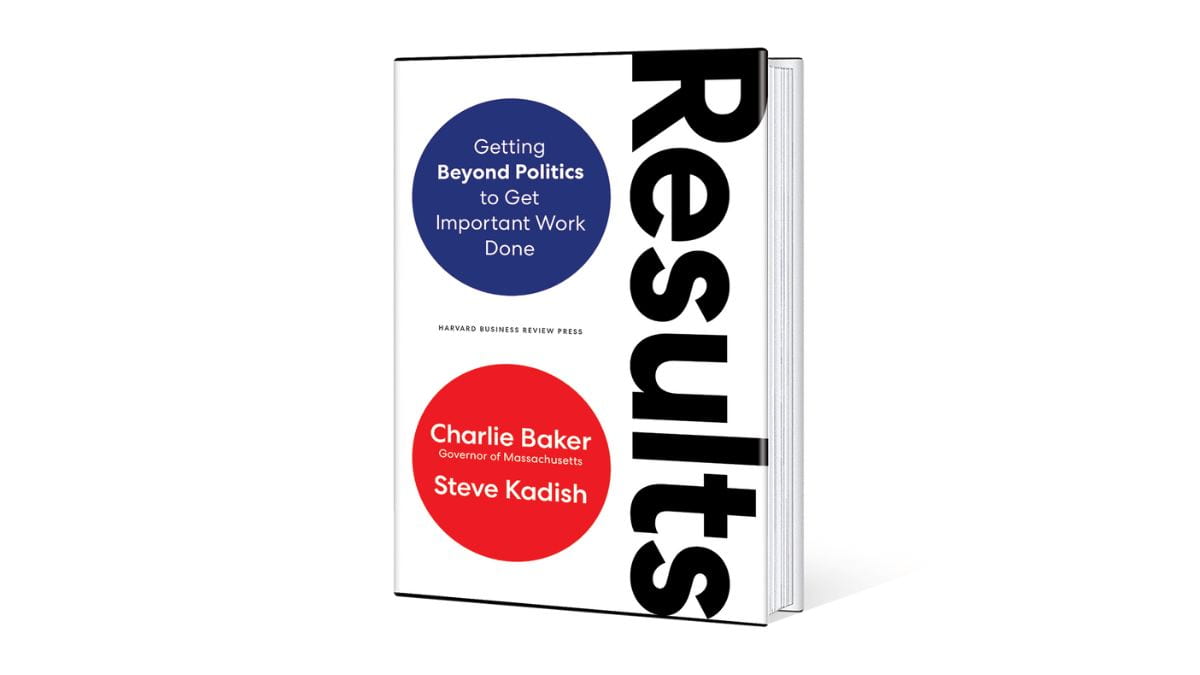written by Salimah Samji
Implementation is often the Achilles heel of good policy. Yet there is dearth of practical tools focused on how you get things done. You can have the best policy, the money, the people, and still not achieve your end goal. Knowing what to do is not a sufficient condition for success.
Results: Getting Beyond Politics to Get Important Work Done, written by Governor Charlie Baker and Steve Kadish, is a wonderful addition to the growing collection of practical guides on the ‘how to‘ of policy implementation. The tips, tools, and tactics shared in the book are relevant for practitioners far beyond the state of Massachusetts and even the United States.
The book has two parts; the first part explains their approach and the second part provides four case studies of how they used their approach to solve real problems in the state of Massachusetts.
Their approach has four parts and is very similar to the PDIA process:
- People are policy: The first step calls for building a team of drivers and doers to solve the problem. They then explain in detail how to select the best people for the team – the “who”. They recommend having both new people as well as veterans who know what is not working and may know what needs to be done, but may not have the permission to act. Some of the characteristics they outline include: know-how, comfort with complexity, able to problem solve, diverse backgrounds/experience, and a collaborative spirit. They exclude people who are know-it-alls and arrogant. They then go further and explain “how” the team should work together. They should be devoted 100% to the effort and they should have trust, humility, respect, and the ability to compromise. “results come when we are talking ‘with’, not ‘at’, one another … it’s easier to point fingers than to do hard work together to make something happen.”
- Building teams is of paramount importance to the PDIA process. You cannot solve complex problems alone. You need a team in which the whole is greater than the sum of its parts. In PDIA we are purposeful about creating both psychological safety and group accountability to build effective teams that live in the learning zone.
- Follow the facts: The second step calls for both data evidence to describe the problem and stories of the human points of pain that brings the abstract down to the personal. They argue that this offers a mind-and-heart perspective on what needs to change. Understanding the facts is essential to the design and implementation of any successful intervention. What is the size of the problem? How long has it persisted? What are causes? They highly encourage going beyond reports to seeking out different perspectives (peers, customers, local universities) and thinking about options instead of a single solution. “It means being objective, learning from others, and uncovering human stories – it’s about what is there not just what you want to see.”
- In PDIA we also use a combination of data and stories to construct our problem narratives. We then use the 5-whys and fishbone diagrams to deconstruct the problem into its root causes. Throughout the process of problem construction and deconstruction we highly recommend including the perspectives of key change agents as well potential agitators for a more robust understanding of the problem (see PDIA Toolkit for more details).
- Focus on how: The third step focuses on both the ‘what’ (policies, programs, proposals) to do to address the problem defined by the facts as well as the ‘how’ to do it – implementation and execution which is the ultimate measure of success. Strategy and structure. They highlight the importance of structure which involves projects, work streams, and a dedicated mission-oriented team, as well as the investment of attention, time, and resources.
- In PDIA we use sequencing (or triple-A) to identify entry points and crawling the design space to find ideas to act upon (see PDIA Toolkit for more details).
- Push for results: The fourth step uses metrics to determine real-time performance and to make appropriate adjustments. These adjustments could include the people involved, understanding of facts, and the what/how of implementation, in order to push progress. “Relentless, incremental progress – not one and done.” They caution against using averages as they can mask the extremes and make things seem ok when they are not. They encourage discussing metrics in the open without fear of repercussion to create a learning environment that allows for adaptation as needed. Finally, they stress the importance of ongoing, proactive, broad communication that is timely, helpful, and accurate. “It’s a two way street – inspired listening – listening to input and learning from our actions.”
- In PDIA we use short two-week iterations to facilitate lessons and leads. We also use our check-in tool to structure the learning and adaptations (see PDIA Toolkit for more details).
In the increasingly complex and uncertain world we live in, we need more practical tools focused on the “how” to drive real change.
I want to end this blog with a powerful quote from the book.
“We are in the problem-solving business, and that business is iterative. Times change, tools change, context changes, expectations change, impact changes. Success is never final. It moves as we move … As long as we stay humble about the constantly changing context in which we operate, focused on our commitment to get better, keep in touch with people we work with and serve, the public will be with us …. Stay focused on the problem to be solved and “dwell in possibility”… ”
To learn more about this book and the approaches used, watch this BSC Seminar hosted at Harvard Kennedy School on November 20, 2022 featuring Steve Kadish.
